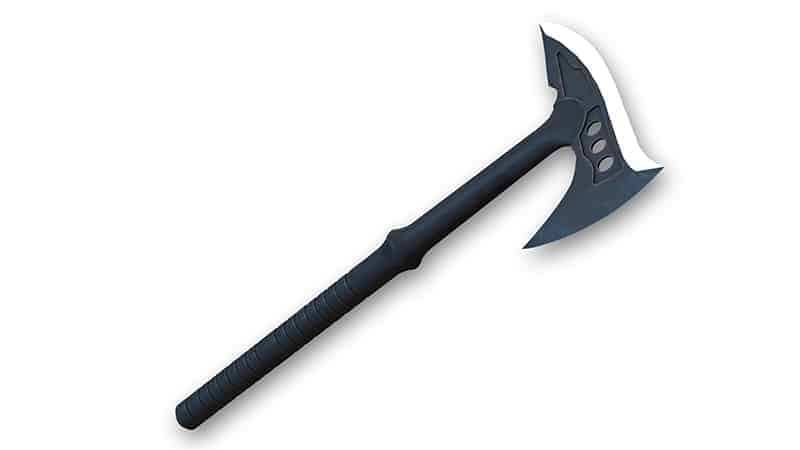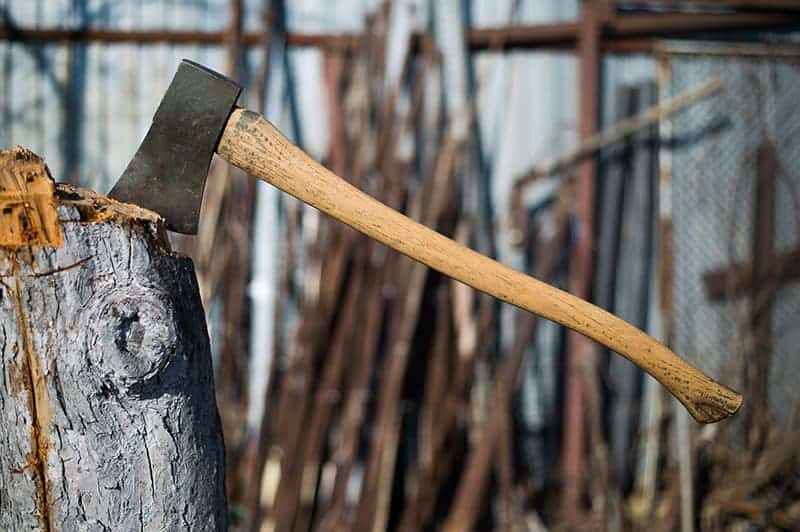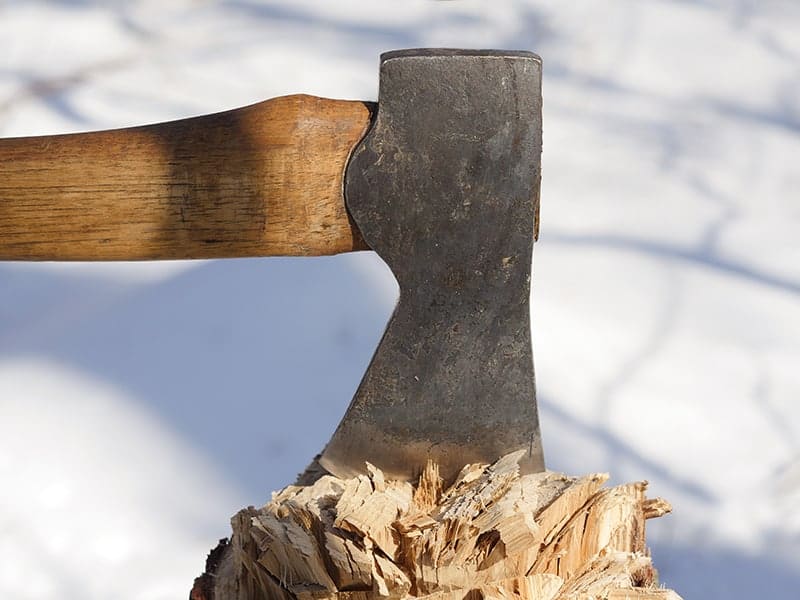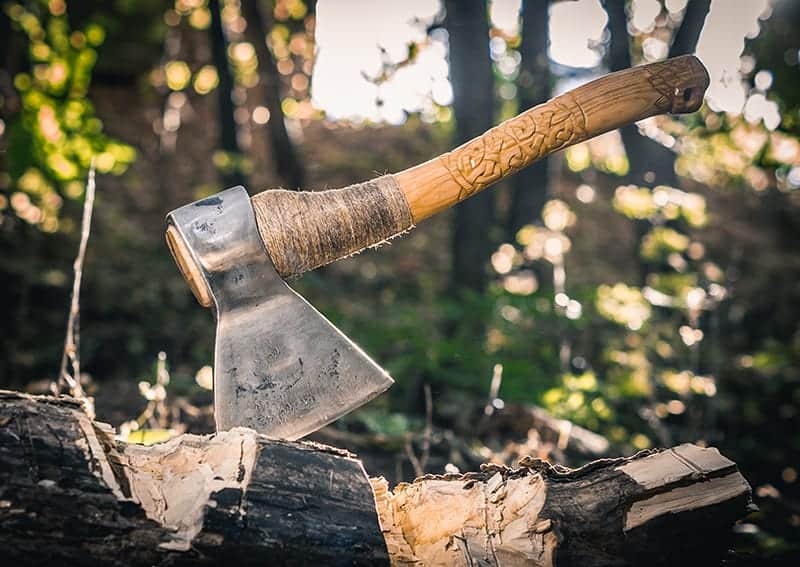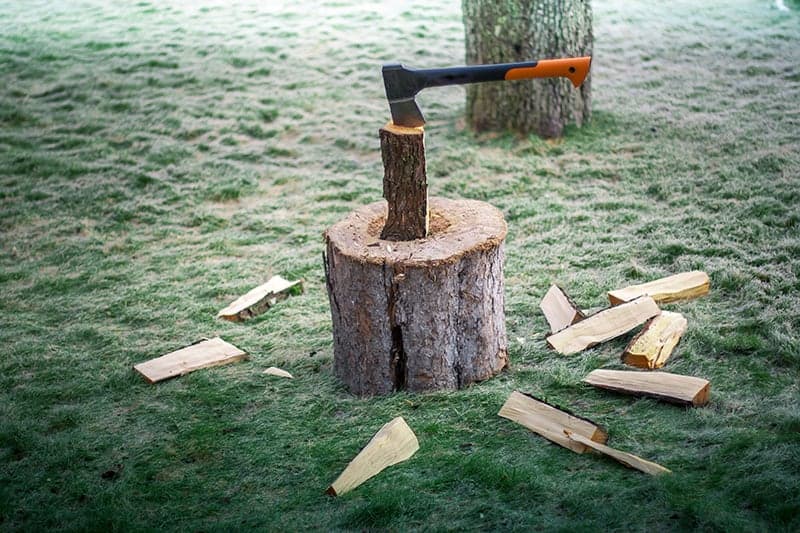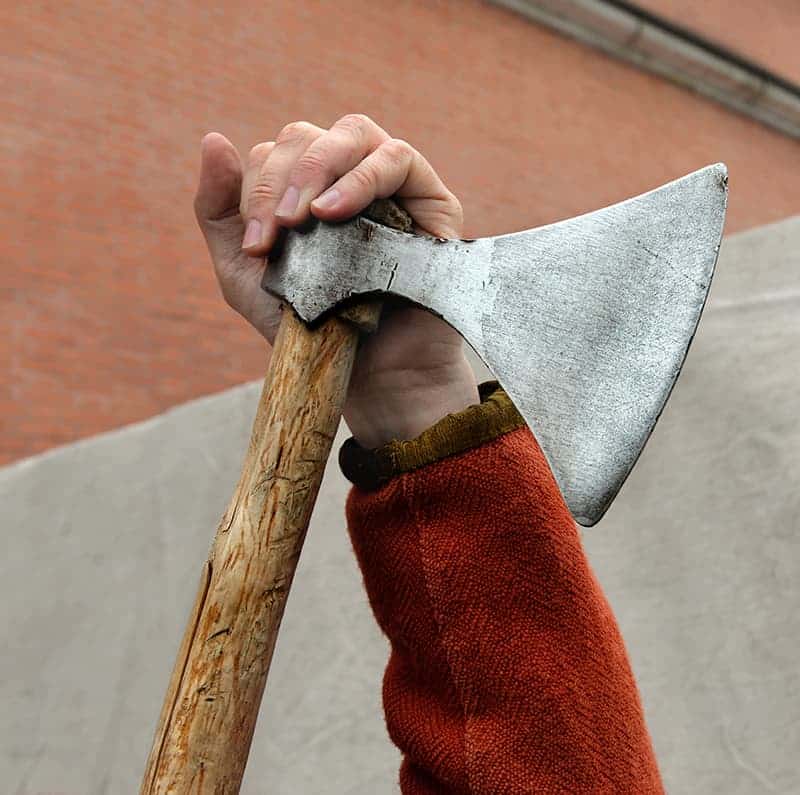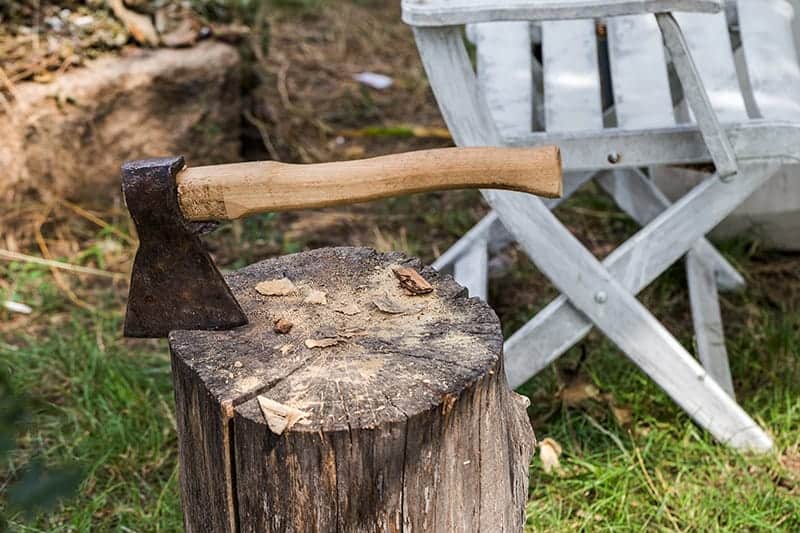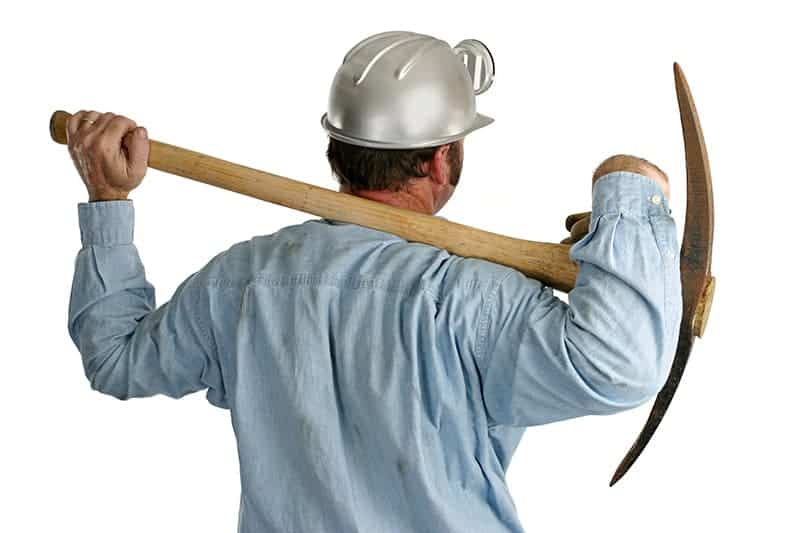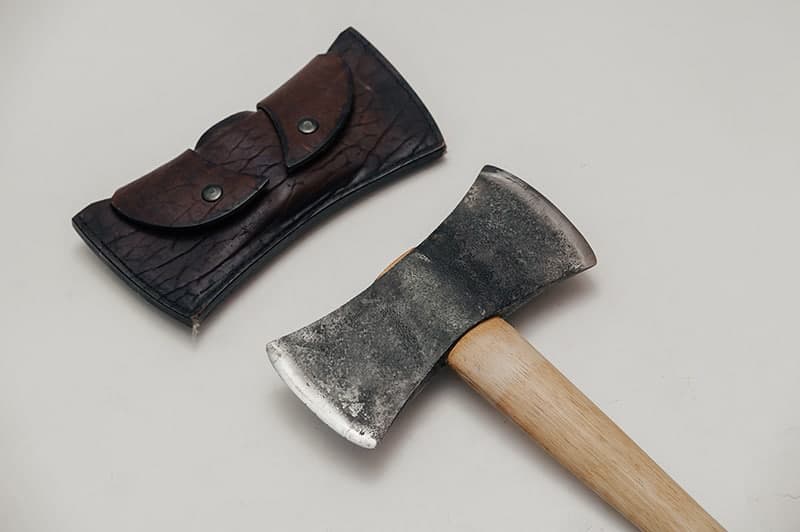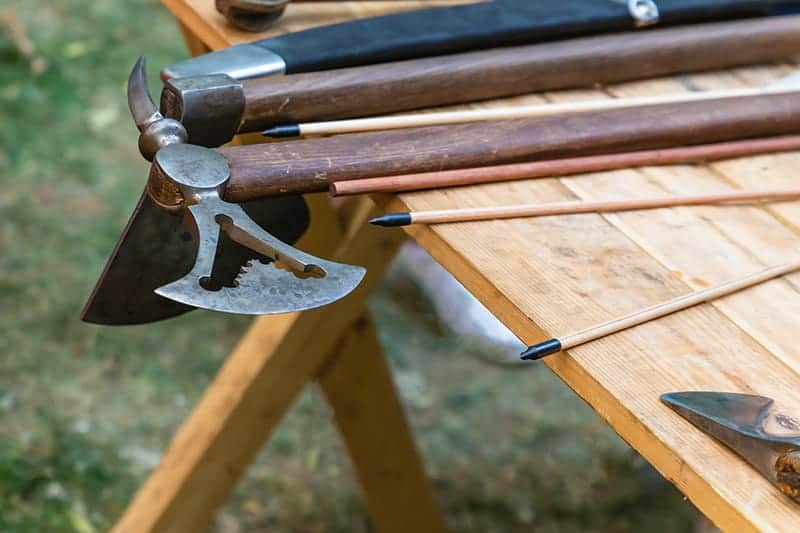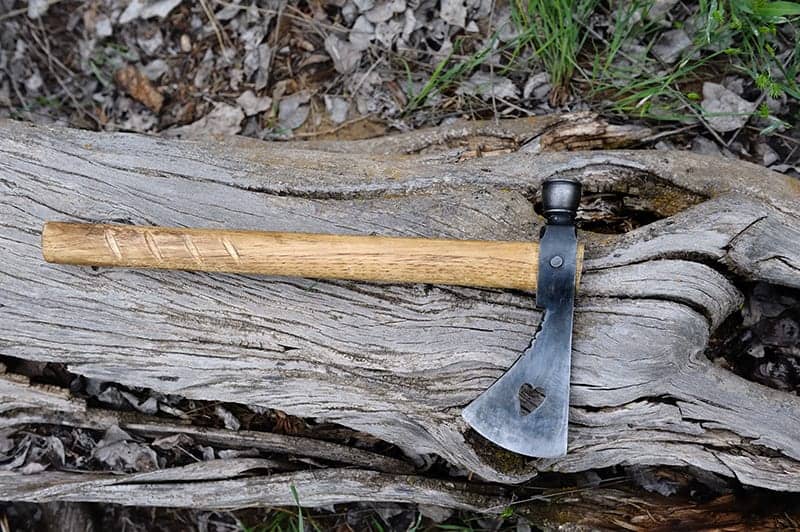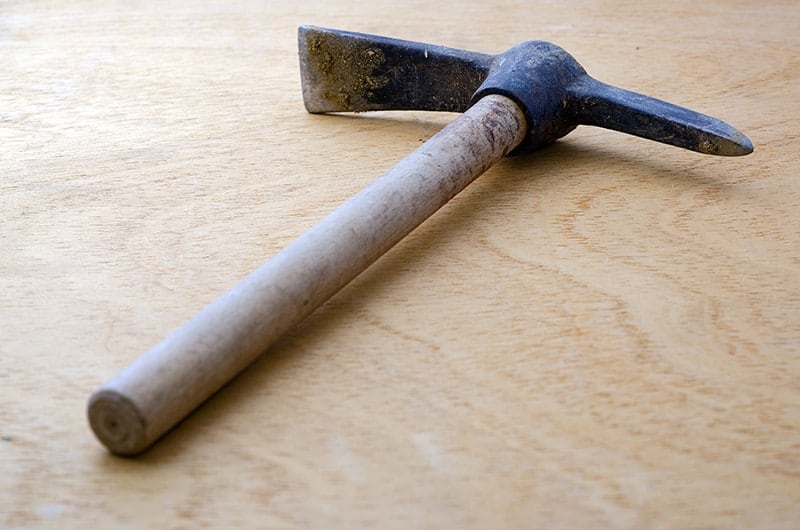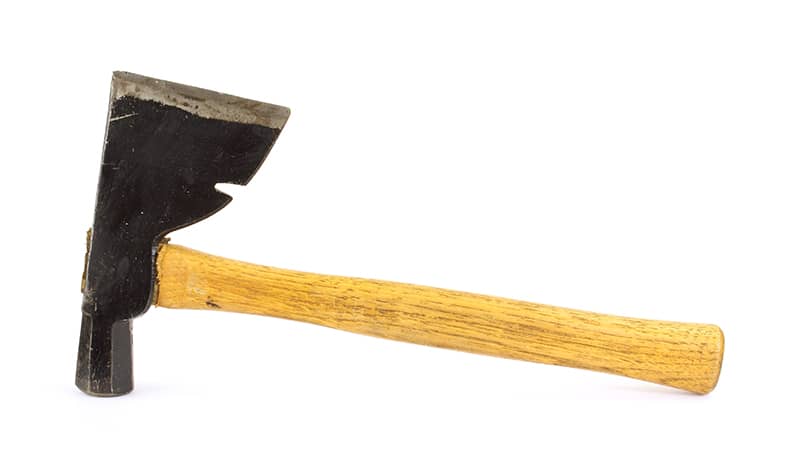Ah, a treehouse. Is there anything that symbolizes the joy, freedom, and m... Read More
- Home >
- 19 Types of Axes and Their Uses (Photos Plus Buying Guide)
19 Types of Axes and Their Uses (Photos Plus Buying Guide)
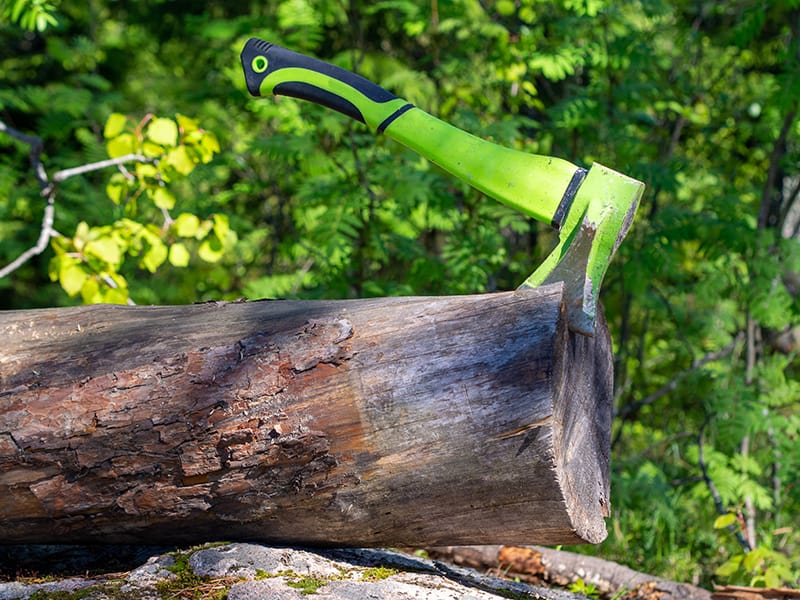
An axe is an ancient tool, with a rich history of uses including felling trees, hunting animals, and weaponry. Today, the axe is most commonly used in the yard or outdoor pursuits, such as camping, but the type of axe you need will depend on the purpose you intend for it.
The most popular axe used today is the felling axe, which is also known as the American axe. There’s a huge range of designs available amongst felling axes, with blade patterns being named after the locations they were created. These patterns include the following.
Common Patterns of Axes
A. Dayton Axe
This pattern is named after Dayton, Ohio. It has a curved blade with a gentle flare. It is a popular pattern that is ideal for general outdoor ax jobs.
B. New England Axe
This axe has a straight edge across the top of the blade and a slightly bearded bottom edge.
C. Michigan Axe
This axe is a common shape for felling axes, having originally risen to popularity in the 1860s. It has a curved head, which is ideal for chopping large trees and dense wood types.
D. Connecticut Axe
This is a popular axe head pattern that takes the shape of a slightly flared wedge. It is great for general copping duties.
Of course, there are many other types of axes besides the well-known felling axe. Some things you will want to consider in your search for the perfect axe are:
Things You Should Consider When Searching a Perfect Axe
A. Handle
The best quality axes have wooden handles, though increasingly big box stores are selling axes with rubber handles. A wooden handle is more ergonomic and will last longer. For the best quality, look for a hickory or ash handle.
B. Weight
The weight of the axe head will affect its use. If it’s too heavy, you will gain force but lose accuracy, while if it’s too light, it won’t cut very deep. For your first axe, the head should weigh no more than three pounds, and you can work up to heavier bits with more experience.
C. Size
The ideal size of an axe handle is a much-debated topic and one that will largely be determined by its intended use. For a felling axe, a longer handle will give a greater swing and more leverage, but a shorter handle will result in better precision. The standard length of a full-sized felling axe is 36 inches, but this should be the maximum length most users should consider. A person who is six foot tall would be best with a handle measuring around 32 inches, as this will offer a good balance between accuracy and force.
Various Types of Axes:
1. Tactical Axe
The tactical axe is a modern invention, which is something of a multi-tool. Also commonly known as a tactical tomahawk, this axe has gained popularity among law enforcement officers, soldiers, and security staff, as well as survivalists. The primary use of this axe is chopping, but it can also function as a close-range weapon, a shovel, a pry bar, and a hammer. It’s ideal for camping trips, as it can help with cooking, chopping wood for campfires, and digging holes. These axes are generally made from steel so that they have the strength to cope with a multitude of tasks.
2. Grub Axe
Also known as a ‘cutter mattock,’ a grub axe has a head with an axe on one side and an adze on the other side. The axe blade will be at a vertical angle, while the adze blade, which is the longer of the two, will be at a horizontal angle. The name ‘grub axe’ comes from the way the tool is used, as it is great for grubbing in compacted soils and rough terrain. These tools are very useful in the garden, as they can dig holes to set new plants in or break up resistant roots of old plants.
3. Felling Axe
These axes are specifically designed for felling trees and chopping logs of wood. The head of a felling axe will weigh between two and four pounds, and sit at the end of a long handle. This long handle enables the user to produce a more powerful swing with greater leverage, making for a better cut. Traditionally the handles are made from hickory wood, which is strong. The grain of the hickory should follow the handle lengthways and curve along with it, for superior strength.
The blade of a felling axe has a flared shape and a sharp and thin tip. These are designed to cut against the grain of the wood, so when felling a tree, it should be swung sideways at the tree trunk. Felling axes are excellent for their intended use of felling small trees and branches, and they chop well; however, they are not ideal for splitting as their blades tend to get stuck in the wood.
4. Forest Axe
Forest axes are robust axes that are solely used for felling trees. They are extremely heavy-duty tools and are too cumbersome to carry around on camping trips, but it would be great to store permanently at a cabin in the woods. These axes have extra long handles and are intended to cut down very large trees. A forest axe will have a sharp and flared blade with a slightly curved tip.
5. Hudson Bay Axe
This type of medium-sized axe was designed by Canadian fur trappers. They used it to chop firewood while on extended trips to the cold north, and also as an all-purpose axe for other tasks. Size-wise, it is in between that of a hatchet and a full-sized felling axe. It can be used with one hand or with both, and is good for smaller chopping and splitting jobs. It won’t be much use on larger trees, but its size makes it more manageable to camping trips.
6. Hatchet
A hatchet is a general all-purpose axe, and is the kind of axe that most people own for light jobs in the yard. These can range enormously in price, from just a few dollars to $100+. They are relatively small compared to some other axes, with a chunky handle most commonly made from hickory wood. The head is weighted, with a flared shape that comes to a sharp-tipped blade. Balance is very important for a good hatchet, as an overall balanced feel will help to produce more accurate swings and cuts, making jobs much quicker and easier to complete. A hatchet is used for felling small trees, and for chopping and splitting logs.
7. Splitting Maul
These axes are specifically designed for splitting logs into kindling. They have a design very similar to a felling axe, with a long wooden handle to give a good swing. When using a splitting maul, you should use a downward swing, not a sideways swing like that used for a felling axe. Unlike felling axes, which cut against the grain of the wood, splitting mauls cut with the grain, which is what results in split wood rather than chopped wood. The head of a splitting maul will be much heavier than a felling axe, at around eight pounds.
The head takes the shape of a chunky wedge, with one sharp end and one blunt end, though the sharp end doesn’t need to be particularly sharp in order to be functional, as it is the shape and weight of the blade that will do most of the work. Because of this, splitting mauls need to be sharpened much less frequently than other axes, as they can work well even when fairly blunt.
8. Broad Axe
A broad axe is also commonly known as a hewing axe, because its primary purpose is hewing, which is the process of turning round-edged lumber into flat-edged timber. This is a type of carpentry that was commonly used before industrial sawmills came into being. In order to facilitate the hewing process, one side of this axe is flat, while the other has a broad beveled edged blade for chopping. It is a medium-sized hand tool which is now commonly used by carpenters, and rarely seen in general use.
9. Carpenter’s Axe
A carpenter’s axe is a craftsman tool which is designed for fine woodworking and isn’t ideal for general felling or chopping jobs. This is a small axe, also sometimes known as a carpenter’s hatchet, though it is slightly bigger than a standard hatchet. Traditionally, this type of axe would have a very straight-edged sharp blade with a flat butt, which would double up as a hammer. The blade of a carpenter’s axe is important when selecting one to use, as a straighter edge is a sign of a higher quality axe which will make a better and more accurate cut. Modern carpenter’s axes also have the addition of a groove in them, which can be used to remove nails from wood. They also typically have a notch on the handle, which allows for a better grip so the user can have more precise control.
10. Miner’s Axe
This axe was originally used by miners in the Middle Ages while mining for copper and silver ore in Europe. These axes feature a short handle and a long head, which are ideal for use in close quarters. Gradually over the centuries, these axes became a status symbol among miners, and may have intricately detailed engraving on the head of the axe.
11. Double Bit Axe
The double bit axe has two blades, one on either side of the head. These will usually be symmetrical from the front, but one blade will blunt while the other is sharp. The sharp side would be used to chop wood or fell trees, and the blunt side used to split the wood into small pieces of kindling ready for the fire. These types of axes are not in mainstream production anymore and are now only used by lumberjacks.
The double head makes them quite cumbersome to carry, as well as being very heavy. Many people prefer not to use them as the added weight of the extra head means the user will tire out when using it more quickly than usual. However, the advantage of the double bit axe is that it essentially is two axes in one, saving you from having two separate axes.
12. Viking Axe
Viking axes were used throughout the Viking Age as battle weapons. Though it is true that many Viking axes were large, you’d be wrong to assume they were brutish and cumbersome. Well-made Viking axes were exceptionally well balanced and could weigh less than two pounds, making them light to carry during battle, and swift to use. The size of these axes varied greatly, though most were double-handed, with handles being as long as 55 inches.
The heads on Viking axes could be varying shapes, but predominantly they are noted for being heavily bearded. This shape was useful for a variety of things in battle, such as hooking an opponent’s ankle to trip them over or hooking their shield out of the way to render them defenseless. The tips of the blade would be incredibly sharp so that they could slash throats like with a knife, and the blunt butt of an axe would also be utilized, usually to bang someone on the head to cause a humiliating but not lethal blow. The heads were almost always made from iron, while the handles were wooden. These types of axes are no longer used today; instead, they are studied to learn about past civilizations.
13. Tomahawk
Tomahawk axes originate from North America, where they were first used by Native Americans. They have a rich military history and have been used in battle since their creation, by both sides in the American Revolution, and later in the Vietnam War. These axes resemble hatchets, but they have a completely straight handle and are noticeably lighter. The straight handle makes them easier to release in combat to throw at an opponent, and the sharp blade makes them useful for a range of jobs, including digging, prying, chopping, and splitting. Though tomahawks are popular among soldiers, they have more recently become fashionable for camping. They are lighter and smaller than hatchets and are therefore easier to carry around. They are multifunctional, able to be used for a range of bushcraft activities. Tomahawks are also popular for use in knife throwing competitions, where they have their own category.
14. Pick Axe
A pickaxe is a hand tool that is shaped like a ‘T.’ It has a wooden or fiberglass handle with a double metal head at the top. Traditionally, both sides of the head would be a pick, though in modern pickaxes, one side of the head will be a pointed pick, and the other side is usually a chisel. The pick end will sometimes have a curve to it or may be completely straight. A pickaxe is a useful garden and landscaping tool, used mostly for breaking up hard soil, rocks, or concrete, while the chisel is commonly used to pry open gaps between rocks or splits in the earth. The chisel also serves as a weight to balance out the axe, and the added weight increases the momentum of the pick when it is swung.
15. Roofing Axe
A roofing axe, also known as a roofing hatchet, is a high-quality craftsman’s tool which is used in roofing, and though it has fallen out of favor due to modern inventions, many roofers still prefer this traditional roofing tool. A roofing axe has multiple purposes, which is great if you’re sat on top of a roof and don’t want to be carrying around a bunch of different tools. The roofing axe has two heads on either side of the handle. One head is a sharp blade that is used for cutting roof shingles.
The other head is a hammer, which is for pounding in roofing nails when fixing shingles to the roof. Often, the hammer head will be magnetized, so you won’t need to hold the nails in place, and instead just attach them to the front of the hammer and jam them in. Roofing axes also have an additional feature, in the form of a node on the sharp blade side. This node is a shingle gauge, which can be used by hooking it over the front face of the shingle below the one you are setting, with the hammer head pointing upwards. The next shingle should sit up against the hammer head, giving you evenly placed rows of shingle.
16. Hunter’s Axe
A hunter’s axe is the essential tool for a hunter, serving the dual purpose of chopping wood and meat. A good hunter’s axe will have a grooved handle, which improves grip even if the user’s hands are wet or sticky, be it from rain or animal blood. An ordinary axe would not work well to skin an animal, as the straight poll with sharp corners is likely to inadvertently damage the animal hide. By comparison, a hunter’s axe has a rounded ‘flay poll,’ which will be more useful for animal skinning. This type of axe is not widely available, and you would need to find a specialist forger to buy a hunter’s axe.
17. Throwing Axe
The original throwing axe was used by foot soldiers in the middle ages as a weapon in battle, which was thrown at an opponent to cause fatal damage. In recent years, axe throwing has been introduced as a competitive sport that is growing in popularity. The axes used in this sport can vary in type and design, but their main feature is that they need to be incredibly durable and sturdy so that they can cope with the pressure they are put under from numerous throws.
The handle of a throwing axe will need to measure a certain length in order to meet the requirements set by the league or federation, which is hosting the sport. You can get different axes for throwing depending on your level in the sport, for example, beginner to intermediate axes, or more professional axes for those more experienced in axe throwing. These axes vary in price range, though typically, the more you spend, the better quality of axe you will receive.
18. Crash Axe
A crash axe is an emergency tool that is typically used in the event of an aircraft crash landing. These axes are a handheld tool with a short handle and a very sharp smooth, or serrated blade. The blade will need to be able to slice through sheet metal in order to gain access to the aircraft from the outside or to cut a hole in the aircraft from the inside to create an exit if other exits are blocked. A crash axe can also pry gaps open and chop interior walls and overhead cabinets. A crash axe must be carried in the cockpit or every aircraft which has 20 or more passenger seats in case of an emergency. Some types of crash axe have a notch upon the blade, which can be used to hook onto sheet metal, while others may have a separate head with a pick on it. These types of axes are typically made entirely from metal and are not commonly owned by anyone outside of the emergency services.
19. Adze
An adze is technically any hand tool that has a sharp cutting blade, but the original adze dates back to the Stone Age. These ancient tools are generally used for woodwork, to carve and smooth out wood. The blade of an adze is set at right angles and is very sharp to carry out refined and detailed carpentry. There are many types of adze, but they can be categorized into two different groups, hand adzes and foot adzes. A hand adze should be swung with just one hand and will have a short handle to accommodate this. A foot adze will be swung with both hands, and have a longer handle. The name ‘foot adze’ refers to the point at which the head usually lands, around foot or shin height.
Related Content
-
13 Simple Treehouse Ideas You Can Build For Your Kids This Weekend (Easy to Expert Levels)
-
How Light Affects Plant Growth – What You Need to Know
Light is something we all take for granted unless you live in the arctic c... Read More
-
Tree Care Tips & Techniques
Trees are among the most notable plants in any landscape. But growing and ... Read More
-
23 Cheap & Amazing Garden Edging Ideas You Can Try
Stuck for inspiration on ways to tidy up the perimeter of your garden? A n... Read More
